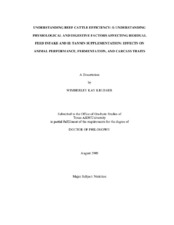| dc.description.abstract | Objectives of this study were 1) to characterize the relationship between beef
cattle efficiency, namely residual feed intake (RFI), and digestive, microbial, and
fermentation parameters in growing beef calves and 2) to examine the effects of added
dietary hydrolysable or condensed tannin on animal performance and efficiency,
fermentation and carcass and non-carcass traits. To accomplish the first objective,
multiple RFI studies were conducted and in all studies RFI was calculated as the
difference between actual and expected dry matter intake (DMI) based on average gaily
gain (ADG) and body weight0.75(BW). A total of 187 head selected out of a population
of 600 head of growing beef calves were evaluated for diet and nutrient digestibility,
ruminal and fecal volatile fatty acids (VFA) concentrations and methane producing
activity (MPA). Low RFI calves consumed less DMI and had lower feed conversion
ratios (FCR) as compared to high RFI calves. Low RFI calves also had higher diet and
nutrient digestibilities compared to high RFI calves. Residual feed intake was negatively
correlated with diet and nutrient digestibilities such that more efficient animals had higher digestibilities. Low RFI calves tended to have lower ruminal propionate and
higher acetate:propionate ratios when fed a high-forage diet. Calves with divergent RFI
did not have different gross microbial populations as evidenced by the
Firmicute:Bacteriodetes ratio, but low RFI calves tended to have higher fecal Prevotella
spp. and lower fecal Spirochaetes and ruminal Cyanobacteria. The importance of these
subtle shifts in microbial ecology is not evident at this time and more research is needed
to fully elucidate the interaction of host and microbes to fully grasp the importance of
minor microbial deviations. No differences in 3 h MPA were detected in low vs. high
RFI calves but low RFI calves had higher fecal MPA when sampled at 24 h; however,
calculated methane emissions were lower for low RFI calves. Tannin supplementation
had no effect on animal performance and efficiency, ruminal fermentation VFA
concentrations, MPA, or ammonia concentrations in finishing beef steers. There was
also no detrimental effect of tannins on carcass traits; however, hydrolysable tannin
supplementation resulted in increased empty rumen mass. Results from these studies
indicate that diet and nutrient digestibility are affected by RFI such that more efficient
calves had higher DMD, microbial ecology is responsive to RFI such that minor
microbial shifts were observed, and tannin supplementation, at the current inclusion rate,
had no effect on animal and carcass performance. | en |


